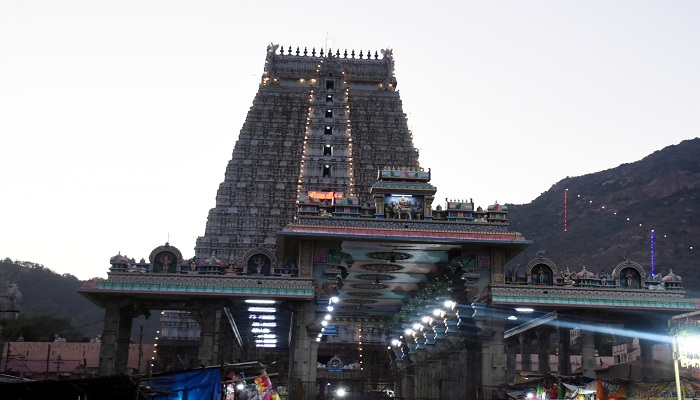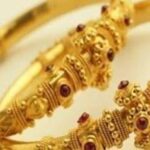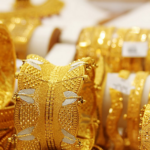
The temple was build to Lord Shiva was built between the 9th and the 10th centuries by the Chola kings of the Tamil empire. The temple is famous known for its Massive Gopurams. This has been made during the time of Chola kings who ruled in the ninth century A.D The 11 tiered East Rajagopuram towers to a height of 217 feet, while the fortified walls pierced with 4 gopura entrances offer a formidable look to this vast temple complex.The Pei Gopuram, Thirumanjana Gopuram and Ammani Ammal gopuram three other than the Raja gopuram. The 1000 pillared hall and the temple tank were built by Krishna Deva Raya of Vijayanagar. Each of the prakarams (outer courtyard) has a huge Nandi and several towers such as the Vallala Maharaja Gopuram and Kili Gopuram. The main holy place of Annamalaiyar facing east houses images of Nandi and the Sun. It is the oldest of all structures in the temple. Right behind on the walls of the sanctum, there is an image of Venugopalaswamy, an incarnation of Hindu God Vishnu. Right around the sanctum, there are images of Somaskandar, Lingodbhava (image of Shiva emanating from lingam), Durga, Chandikeswarar, Gajalakshmi, Arumugaswami, Dakshinamoorthy, Swarna Bairavar, Nataraja and Palliyarai (divine room meant for resting deities) these are regular features of Shiva temples in South India. The shrine of the consort, Unnamulai Amman lies in the second precinct of the temple. Samantha Vinayagar (elephant god) shrine is located to the north of the flag staff and Bali peeta (platform for sacrifice). To the south of the 1000-pillared hall, there is a small shrine for Subramanya and a large tank. (underground lingam) is the place where saint Ramana is believed to have done his penance. The shrine of Sivagangai Vinayagar is present in the northern bank of the Sivaganga tank. It is one of the PanchaBhootaStalambhoota Sthalam - representing five basic elements.
This is the Tejo Sthalam among the PanchaBhootaStalam Bootha Sthalas representing Fire. The others are - Thiruvanaikaval (Aapo sthalam - Water) Kanchipuram (Prithvi sthalam - Earth) Kalahasti(Vayu sthalam - Air) Chidambaram (Akasa sthalam - Space). The temple is revered by the Tamil Saiva canonical work of the 7th century, the Tevaram, by Tamil saint poets called the nayanars and is classified as a Paadal Petra Stalam the temples revered in Tevaram. It is believed that the 9th century Saiva saint poet Manikkavasagar composed the Thiruvempavai in the temple. The Karthigai Deepam festival celebrated during the full moon day in November December and a huge beacon is lit on the top of the hill. It can be seen from miles around and believed to be Shiva's linga of fire joining the limitless skies. The event is witnessed by 3 million pilgrims. During each full moon day, a worship called Girivalam is followed when pilgrims circumnavigate the base of the temple and the Annamalai hill.The Girivalam is carried out by close to 1 million pilgrims.
Thiruvannamalai is one of the PanchaBhootaStalam Bootha Sthalangal representing the fire element along with Chidambaram, Sri Kalahasti, Thiruvanaikoil and Kanchipuram representing sky, air, water and earth respectively. Four Brahmotsavams are celebrated every year, the most famous of which is the one celebrated during the Tamil month of Karthikai (November/December). The ten day event culminates on the day of Karthigai Deepam. On that evening, a huge lamp is lit in a cauldron with three tons of ghee at the top of the Annamalai hill. Every full moon night, tens of thousands of pilgrims worship Shiva by circumambulating the Arunachala hill barefoot. The circumambulation covers a distance of about 14 km. On the yearly Chitra Powrnami (full moon) night in the Tamil calendar year, hundreds of thousands of pilgrims from across the world visit the sacred town. Advaita Vedanta guru Ramana Maharshi lived in Thiruvannamalai for fifty three years until his death in 1950. His ashram, Sri Ramanasramam, is located at the foot of the Arunachala hill, to the west of the town. Seshadri Swamigal and Yogi RamSurat Kumar are examples of two other gurus who lived in this city.
DAILY POOJAS AT TEMPLE
| 05.30 AM | Ushathkalam |
| 08.00 AM | Kaalasanthi |
| 10.00 AM | Uchikkalam |
| 06.00 PM | Sayarakshai |
| 08.00 PM | IrandamKalam |
| 09.30 PM | Artha Jamam |
| Daily Pooja Details | |||
| Opening Time | Morning 5.00 AM | ||
| Komatha Pooja | 5.15 AM | ||
| Palli Ezhuchi Pooja | 5.30 AM | ||
| Ushakala Pooja | 6.00 AM | ||
| Kalasanthi Pooja | 8.30 AM | ||
| Uchikala Pooja | 11.00 AM | ||
| Closing Time | Noon 12.30 PM | ||
| Opening Time | 3.30 PM | ||
| Sayaratchai Pooja | Evening 5.30 PM | ||
| 2m Kala Pooja | Night 7.30 PM | ||
| Arthajama Pooja | 9.00 PM | ||
| Palliaral Pooja | 9.15 PM | ||
| Closing Time | 9.30 PM | ||









































